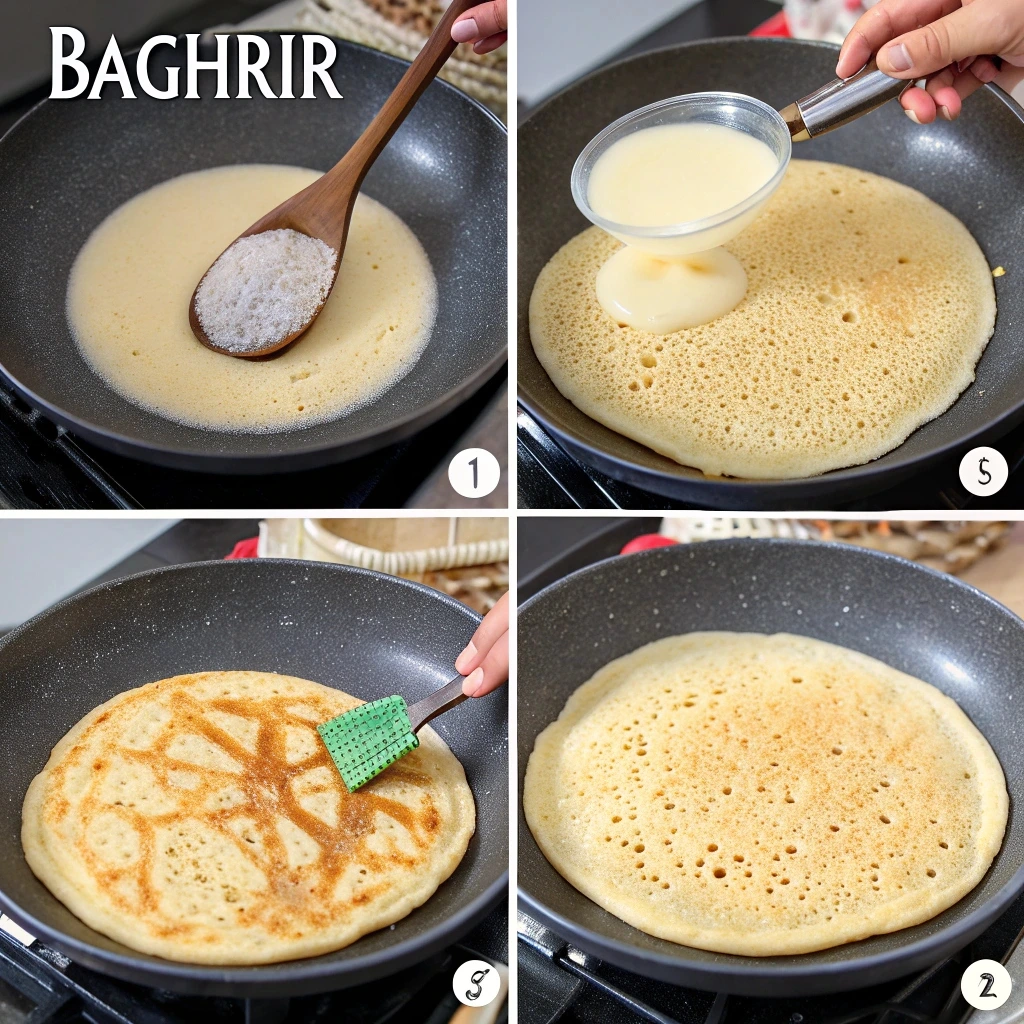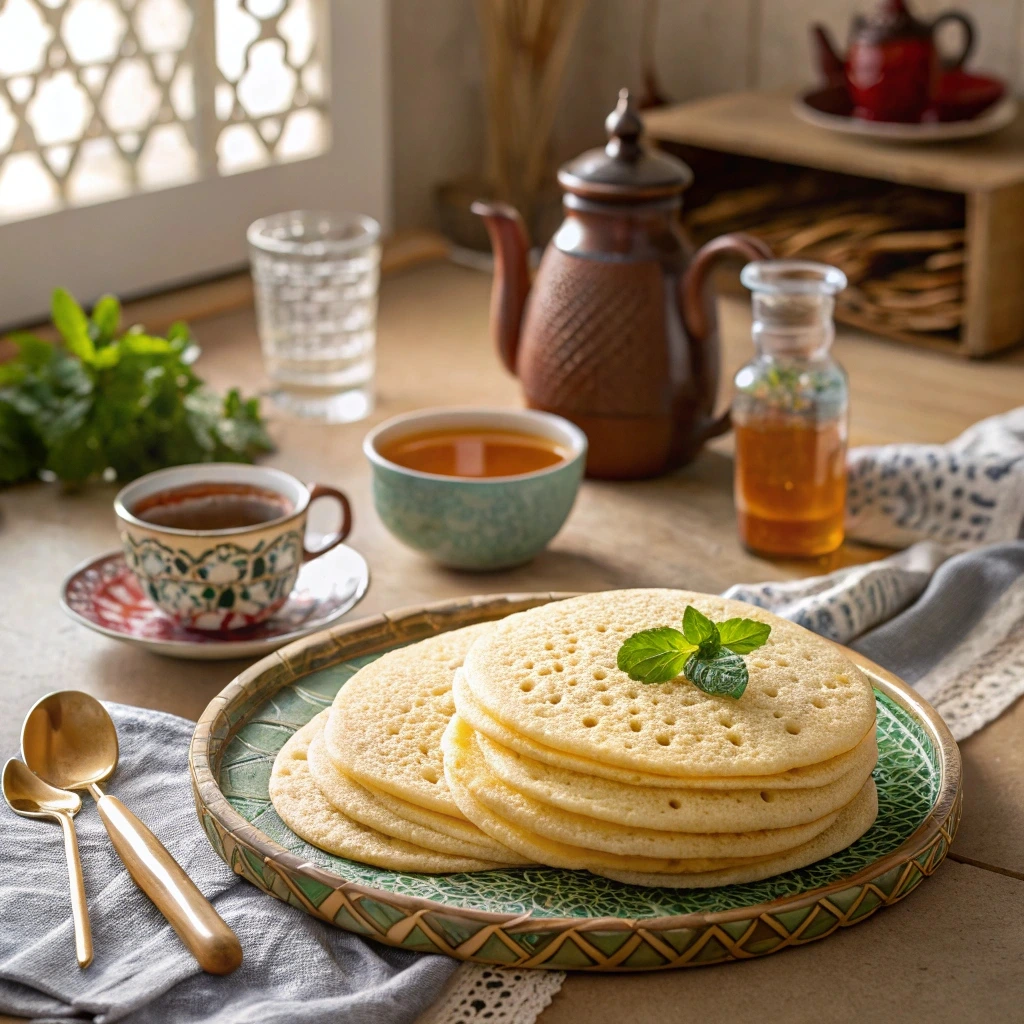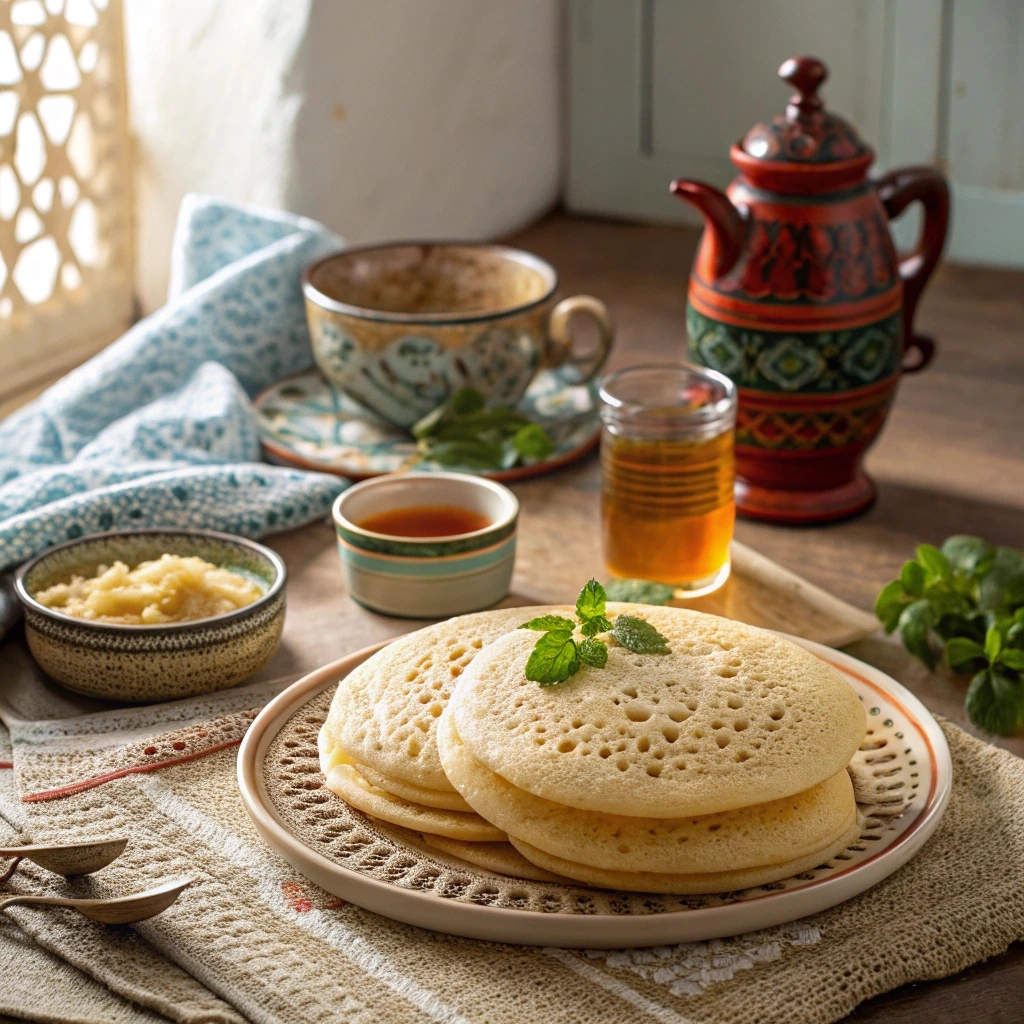If you’re someone who lives for breakfast—or brunch with a twist—you’re in for a delicious ride. In this guide, we’ll dive deep into the fascinating world of Moroccan pancakes, especially the iconic Baghrir, often called the “pancake with a thousand holes.” But wait, there’s more! We’ll also explore their flaky cousins like Msemen and Harcha, walk you through traditional recipes, and uncover serving tips that make Moroccan breakfasts truly unforgettable.
Moreover, you’ll get to learn how to make them from scratch, avoid rookie mistakes, and even pair them with classic Moroccan beverages like mint tea. Oh, and did we mention there’s a FAQ section to answer your burning pancake questions?
Whether you’re a home cook or a breakfast enthusiast, this guide will give you everything you need to master Moroccan pancakes—semolina, yeast, honey butter, and all.
Table of Contents
What Are Moroccan Pancakes?
The Origin and Cultural Significance of Baghrir
Moroccan pancakes, or Baghrir, are so much more than just a breakfast item—they’re a cultural icon. With their spongy texture and signature surface full of tiny holes, they’ve earned the nickname “the pancake with a thousand holes.” But don’t let that poetic name fool you. These golden treats are packed with flavor and tradition.
Originating in North Africa, particularly Morocco and Algeria, Baghrir is often made during special occasions like Ramadan or Eid. However, they’re also a staple in everyday Moroccan breakfasts. Passed down through generations, the recipe brings families together around the kitchen. And the best part? They’re usually served with melted butter and honey—a sweet combo that melts right into those tiny holes.
Moreover, Baghrir represents the Moroccan knack for transforming simple ingredients into something utterly delicious. It’s a dish that whispers heritage with every bite. As a result, its popularity has spread far beyond Moroccan borders and can now be found in kitchens and cafes across the globe.
How Baghrir Differs From Regular Pancakes
So, how exactly are Moroccan pancakes different from the regular pancakes you might flip on a Sunday morning? Well, for starters, Baghrir is yeast-based, not baking powder-based. That means it’s fermented, giving it a slightly tangy flavor and a wonderfully airy texture.
Also, Baghrir is made from a mix of semolina and all-purpose flour, which gives it a unique grainy consistency. Unlike American pancakes, which are browned on both sides, Baghrir is cooked only on one side. This cooking method creates thousands of tiny bubbles that pop as it cooks, giving it its distinctive perforated appearance.
In addition, you won’t typically see Moroccan pancakes drowned in syrup. Instead, they’re drizzled with honey and butter or sometimes dipped into Amlou, a nut-based Moroccan spread. It’s an experience—one that’s steeped in culture and absolutely unforgettable.
And yes, they’re ridiculously fun to say: Bah-GREER. Go ahead, give it a try.
Moroccan Pancakes Varieties Explained
Baghrir – The Pancake with a Thousand Holes
When most people talk about Moroccan pancakes, they’re referring to Baghrir. Known for its spongy texture and crater-like surface, Baghrir is truly in a league of its own. Unlike American-style pancakes, these are only cooked on one side. As a result, steam forms bubbles that create the signature holes on the surface—perfect for soaking up honey butter or Amlou.
Moreover, Baghrir is light, airy, and has a mild tang from the fermentation process. It’s typically served warm and fresh, but it holds up well when reheated. That makes it a go-to choice not only for breakfast but also for iftar during Ramadan.
In addition, its semolina-rich batter sets it apart from other pancakes around the world. The flavor is slightly nutty, the texture is soft and chewy, and the taste? Unforgettable.
Msemen and Harcha – Flaky & Gritty Cousins of Baghrir
While Baghrir often gets all the spotlight, Msemen and Harcha are two lesser-known Moroccan pancakes worth discovering. Both are made with different textures and cooking styles, offering even more variety to Moroccan breakfasts.
Msemen is a square, flaky flatbread made by folding layers of dough and frying them until golden. It’s often enjoyed with jam, honey, or cheese. Think of it as the buttery croissant of North African pancakes—crispy outside, soft inside.
On the other hand, Harcha is a semolina-based griddle cake that’s shaped into thick discs and pan-fried. Because of its dense, crumbly texture, it’s often compared to cornbread but with a Middle Eastern twist.
These varieties highlight the incredible diversity in Moroccan pancake recipes. Therefore, whether you crave spongy, flaky, or crumbly, there’s a Moroccan pancake with your name on it.
Ingredients Breakdown and Nutritional Info
Traditional Ingredients Used in Moroccan Pancakes
Creating authentic Moroccan pancakes doesn’t require a long list of exotic ingredients. In fact, one of their many charms is their simplicity. Most ingredients are pantry staples—but they come together in magical ways.

Here’s a basic ingredient list for traditional Baghrir:
| Ingredient | Quantity |
|---|---|
| Fine Semolina | 1 cup (about 150g) |
| All-purpose flour | ½ cup (about 60g) |
| Warm water | 2 cups (about 480ml) |
| Active dry yeast | 1 tsp (about 4g) |
| Baking powder | 1 tsp (about 5g) |
| Salt | ½ tsp (about 2g) |
| Sugar | 1 tsp (about 5g) |
For toppings, you’ll often see:
- Melted butter
- Honey
- Amlou (a Moroccan almond and argan oil spread)
Moreover, the combination of semolina and yeast gives Baghrir its sponge-like texture. The yeast also adds a mild fermented note, making it stand out from other pancake types.
Are Moroccan Pancakes Healthy? Nutrition Facts You Should Know
Let’s talk health. Moroccan pancakes aren’t just delicious—they’re fairly nutritious too, especially when compared to syrup-soaked Western pancakes. Thanks to semolina, they offer a good source of slow-digesting carbs, which keep you full longer.
However, moderation is key—especially if you’re generous with toppings like honey butter. That said, you can always swap in healthier versions like organic ghee, maple syrup, or even a drizzle of date molasses.
Therefore, Moroccan pancakes can fit nicely into a balanced diet. Just pair them with a cup of mint tea, and you’re good to go.
Step-by-Step Recipe for Traditional Baghrir

Essential Ingredients List
To make authentic Moroccan pancakes—Baghrir—you only need a few simple ingredients, but getting the texture just right is all about balance. Below is the traditional list:
| Ingredient | Quantity |
|---|---|
| Fine Semolina | 1 cup (150g) |
| All-purpose Flour | ½ cup (60g) |
| Warm Water | 2 cups (480ml) |
| Active Dry Yeast | 1 tsp (4g) |
| Baking Powder | 1 tsp (5g) |
| Salt | ½ tsp (2g) |
| Sugar | 1 tsp (5g) |
These ingredients create a bubbly batter that results in that signature “thousand hole” texture. However, always make sure your water is warm—not hot—to properly activate the yeast without killing it.
Preparation Steps with Expert Tips
Step 1: Mix the dry ingredients
In a large mixing bowl, whisk together the semolina, flour, yeast, salt, sugar, and baking powder. Make sure everything is evenly distributed.
Step 2: Blend the batter
Now, pour in the warm water gradually. Blend using a stand mixer, hand whisk, or even a blender until the mixture is completely smooth. There should be no lumps at all.
Step 3: Let it rest
Cover the bowl with a clean kitchen towel. Let the batter ferment in a warm spot for about 30–40 minutes. You’ll notice tiny bubbles forming—that’s a good sign!
Step 4: Cook one side only
Preheat a non-stick skillet over medium heat. Pour a small ladle of batter onto the dry pan (no oil). The batter will start bubbling—do not flip it. Once the surface sets and all bubbles pop, remove the pancake.
Step 5: Serve immediately or stack
Traditionally, Baghrir is served warm with melted butter and honey. But they can also be stacked and reheated later—perfect for busy mornings.
Moreover, for a savory twist, you can stuff them with cheese or herbs. Feeling experimental? Try pairing Baghrir with a tangy dip like in this Scallion Pancakes Recipe Guide from PopinRecipes for more fusion ideas.
Tips to Get Those “Thousand Holes” Right
Why Batter Consistency Matters
Let’s face it—those signature holes on Moroccan pancakes don’t just appear by magic. The batter’s consistency plays a crucial role. Too thick? The bubbles won’t form. Too thin? Your pancake will turn into a soggy crepe. Therefore, the golden rule is this: the batter should be pourable but slightly thicker than crepe batter.
Moreover, blending the mixture properly breaks down any lumps, ensuring even fermentation. If the mixture sits too long or is over-fermented, the batter may collapse before cooking. So, aim for the sweet spot: bubbly, airy, and just thick enough to hold shape.
The Right Pan and Heat Control Techniques
Believe it or not, even the best batter will fail if the pan’s too hot—or not hot enough. Preheat your non-stick pan over medium heat, then test with a drop of water. If it sizzles gently, it’s ready.
However, avoid greasing the pan. Adding oil can ruin the delicate bubble formation. Cook each pancake for about 1–2 minutes until all bubbles have popped. If bubbles aren’t appearing, reduce the heat slightly and give the batter another stir.
Finally, resist the urge to flip! Baghrir is proudly one-sided—just like its North African heritage.

Variations Across Moroccan Households
Regional Twists on the Classic Baghrir
Although Moroccan pancakes share a common base, how they’re prepared can vary from one region—or even one household—to another. For example, some families in northern Morocco prefer adding a touch of orange blossom water to the batter, lending a floral note to the dish. Meanwhile, in the south, Baghrir is often cooked over a clay skillet for a slightly smokier flavor.
Moreover, the texture may differ based on semolina type. Some regions use fine semolina, while others prefer a coarser grind for added body. Therefore, the result ranges from pillowy soft to slightly chewy, but both are equally authentic and delicious.
In addition, the toppings can vary too. While honey and butter are staples, some serve Baghrir with olive oil, fresh cheese, or even a savory tomato-onion sauce. These regional twists not only keep the dish interesting but also reflect Morocco’s rich culinary diversity.
Modern Fusions: Sweet, Savory, or Stuffed
Today, Moroccan pancakes are making waves beyond the traditional breakfast table. Many creative cooks are stuffing Baghrir with spiced meats or vegetables, folding them like tacos for a fusion-style snack.
For sweet lovers, Nutella or fruit preserves have become trendy toppings. So, whether you’re craving savory fillings or dessert-style flair, there’s always a new way to enjoy Baghrir in modern kitchens.
How to Serve Moroccan Pancakes
Traditional Toppings: Honey-Butter, Amlou, or Jam
Serving Moroccan pancakes is just as important as cooking them. Traditionally, Baghrir is served warm and drizzled with a mixture of melted butter and honey. This golden glaze seeps into the holes, creating a sweet and buttery bite in every forkful.
Another beloved topping is Amlou, a thick spread made from almonds, argan oil, and honey. It’s rich, nutty, and pairs perfectly with the soft texture of Baghrir. Some regions also enjoy Baghrir with local jams made from figs, apricots, or dates.
For those who prefer less sweetness, a simple pat of salted butter can elevate the pancake’s natural flavor. Moreover, serving with a hot cup of Moroccan mint tea completes the experience and makes for an authentic Moroccan breakfast.
When and How They Are Served in Moroccan Homes
In Moroccan homes, Baghrir isn’t just breakfast—it’s tradition. It’s commonly served during Ramadan, Eid, and even casual weekend mornings when the family gathers. Therefore, these pancakes often symbolize hospitality and comfort.
Furthermore, Baghrir is usually laid out on a large communal plate, encouraging shared meals. Whether topped with sweet spreads or paired with savory additions like olives and cheese, the serving style remains warm and communal.
If you’re feeling inspired, why not host a Moroccan-themed brunch? Include a few variations of Moroccan pancakes, mint tea, and fresh fruits for a memorable feast that your guests won’t forget.
Pairing Moroccan Pancakes with Other Moroccan Dishes
Baghrir and Moroccan Mint Tea: A Cultural Match
If you’ve ever sat down to enjoy Moroccan pancakes, you’ll know they’re not complete without a warm glass of Moroccan mint tea. This tea, made with fresh mint leaves and green tea, is both sweet and refreshing. Together, they create a balance of textures and flavors—soft, spongy pancakes paired with cool, fragrant tea.
Moreover, this pairing isn’t just delicious; it’s a cultural ritual. Whether during Ramadan or a lazy weekend, serving Baghrir with tea is a timeless Moroccan tradition.
Hearty Additions: Eggs, Olives, and Cheese
While Moroccan pancakes are delightful on their own, many families like to build a fuller breakfast plate. Hard-boiled eggs, salty olives, and soft cheeses often join the table.
In addition, some even roll up Baghrir around savory fillings like egg and cheese for a quick, hearty wrap. Therefore, whether sweet or savory, Baghrir is the perfect base to mix and match flavors based on your mood.

Moroccan Pancakes Around the World
From Moroccan Breakfast to Global Brunch Menus
Over time, Moroccan pancakes have traveled far beyond North Africa. Thanks to food bloggers, chefs, and cultural enthusiasts, Baghrir is now a popular feature on brunch menus across Europe and North America.
In trendy cafes, they’re often served with toppings like maple syrup, berries, or even Greek yogurt. Although these pairings are modern, they still honor the core texture and richness of the original recipe.
Influence of Baghrir in North African and Middle Eastern Cuisine
Baghrir’s influence doesn’t stop at the Moroccan border. Across Algeria and Tunisia, similar pancakes are made with slight differences in ingredients or technique.
Furthermore, Baghrir is sometimes confused with Atayef, a Middle Eastern stuffed pancake. While both are spongy and yeasted, Baghrir is distinct in its single-sided cooking and iconic “thousand holes.”
As a result, Moroccan pancakes stand proudly as a cultural dish that connects regions while staying unique in flavor and form.
Frequently Asked Questions
Why do Moroccan pancakes have holes?
The iconic holes on Moroccan pancakes, especially Baghrir, are a result of the unique fermentation process. As the yeast in the batter activates, it produces air bubbles. Then, when the batter hits the hot pan, these bubbles rise and pop—leaving behind thousands of tiny craters.
Moreover, Baghrir is cooked only on one side, which helps preserve the open holes and give it that signature texture. These holes aren’t just for looks—they act like little pockets that soak up butter, honey, or Amlou, enhancing every bite.
Can I make Moroccan pancakes without yeast?
Yes, you can, but the texture will change. Traditional Moroccan pancakes rely on yeast for their airy, spongy texture and fermented flavor. However, if you’re short on time or ingredients, baking powder alone can offer a quicker version.
That said, the result will be slightly denser and may lack the same depth of flavor. Still, it’s a decent alternative, especially for beginners.
What flour is best for Baghrir?
The best flour combination for Moroccan pancakes is a mix of fine semolina and all-purpose flour. Semolina gives the pancakes their slight graininess and heartiness, while the all-purpose flour helps bind the mixture smoothly.
In addition, using fine semolina rather than coarse is key to achieving the smooth, pourable batter needed for perfect Baghrir.
How to store and reheat Moroccan pancakes?
Storing Moroccan pancakes is easy. Let them cool completely, then layer with parchment paper and refrigerate in an airtight container for up to 3 days.
To reheat, use a skillet over low heat for 1–2 minutes. Alternatively, you can steam them briefly to retain softness. Avoid microwaving directly, as this can dry them out.

